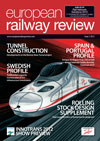Rail wins gold
Posted: 26 September 2012 | | No comments yet
The railway industry comes in for more than its fair share of criticism. Complaints about punctuality, ticket prices and passenger service are common. Some of it is deserved, but a lot of it is not. Often, it seems our industry is judged by different criteria from others. For example, why is it that journalists so often quote the lowest ticket price between two cities when talking about budget airlines, but quote the highest price when discussing rail services? And why does a coach crash with multiple fatalities merit only a few lines on an inside page of a newspaper, while a rail accident in which there may be only a few injuries is front page news?
Thus it is heartening when rail gets praised for its service – when this happens, we know we must have done really well, given the harsh standards by which our industry is normally judged! Such was the case with the 2012 Olympic Games. There was widespread praise for the way London’s transport system worked during the Games – and that means primarily rail, as our mode was responsible for over half the transport to the Olympic venues.


The railway industry comes in for more than its fair share of criticism. Complaints about punctuality, ticket prices and passenger service are common. Some of it is deserved, but a lot of it is not. Often, it seems our industry is judged by different criteria from others. For example, why is it that journalists so often quote the lowest ticket price between two cities when talking about budget airlines, but quote the highest price when discussing rail services? And why does a coach crash with multiple fatalities merit only a few lines on an inside page of a newspaper, while a rail accident in which there may be only a few injuries is front page news?
Thus it is heartening when rail gets praised for its service – when this happens, we know we must have done really well, given the harsh standards by which our industry is normally judged! Such was the case with the 2012 Olympic Games. There was widespread praise for the way London’s transport system worked during the Games – and that means primarily rail, as our mode was responsible for over half the transport to the Olympic venues.
London poured money into its public trans – port system ahead of the Games, expanding Stratford station, opening a new line on the Docklands Light Railway (DLR), extending the East London Line, and many other projects. It all paid off, with none of the transport chaos that doom-mongers had predicted.
One of the stars of the show was the highspeed Javelin service between the Olympic Park and central London. This was operated using Hitachi-built Class 395 EMUs, shuttling between a park-and-ride site at Ebbsfleet in the south-eastern suburbs of London and St Pancras International in the heart of the city, calling en route at Stratford International for the Olympic Park.
The journey time between Stratford International and St Pancras International is just six minutes, making this a fast and reliable link between the Games site and the centre of the city. Indeed, so fast and reliable that it attracted multi-millionaire sports stars more used to chauffeured limousines than public transport. Olympians such as U.S. basket-baller Kobe Bryant, who plays for the LA Lakers – he commented on the Javelin service: “You can’t buy private transport this good.”
It was not only the Javelin service that was patronised by sports stars. Venezuelan fencer, Ruben Limardo Gascón, boarded a DLR carriage with his gold medal around his neck. American 400 metres silver medallist, Lashinda Demus, rode the 257 bus home each night. Many other athletes were seen on other parts of the London public transport system. These stars, voting with their feet, showed that the public transport system worked.
There are lessons to be learnt here. First and foremost, meticulous planning pays off. From the very outset, when it was bidding to hold the 2012 Games, London knew that transport was a potential Achilles’ heel: this spurred the city on to plan infrastructure improvements targeted at the Olympic venues. These projects were executed on time, ready to help in the shifting of Olympic crowds, but also forming a valuable legacy for the future as the new railway lines and extra public transport capacity will serve to regenerate an area of the city which, when the limelight of the Olympics is off it, is struggling economically.
There was also meticulous planning for the operational period. Transport for London conducted an extensive information campaign aimed at diverting passengers away from potential hotspots: those interchanges where Games throngs would be mixing with London’s usual commuting crowds. It worked: the muchfeared two-hour waits to gain access to platforms failed to materialise.
A key part was played by the operating staff. The best way to stop crowds building up is to shift the passengers as soon as they start to appear: London’s public transport managed to do this by raising its game and operating smoothly over extended opening hours. Of course, behind the scenes was some heroic maintenance work, with run-of-the-mill servicing completed in shorter hours than usual and trains and infrastructure kept running despite the higher loads than normal. There was the odd hiccup – a signal failure here and there – but by and large, the advance work in getting the system ready paid off.
The performance of London’s public transport system has raised the bar for Rio, showing the 2016 host-city how it should be done. But perhaps more importantly, it has showed the critics that we do know what we are doing. The 2012 Olympics has proved beyond doubt that rail is the best way to shift large crowds of people in a short time.


